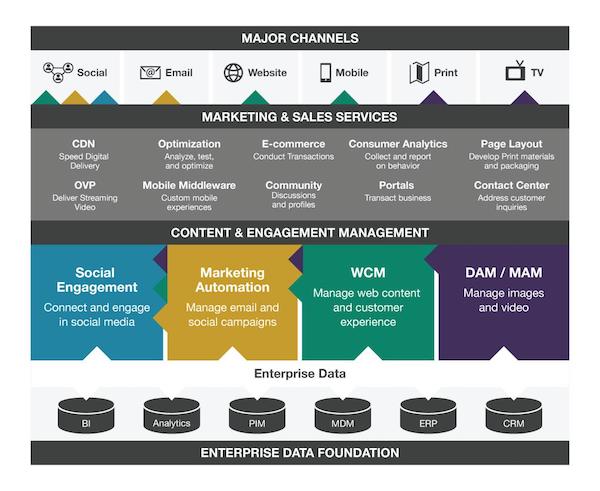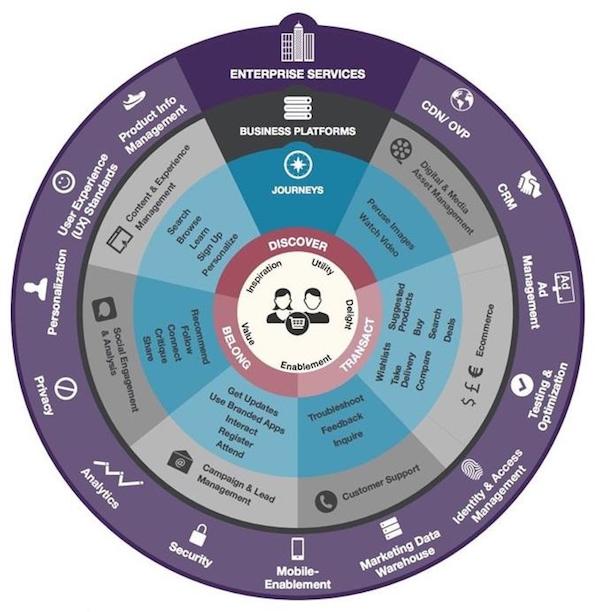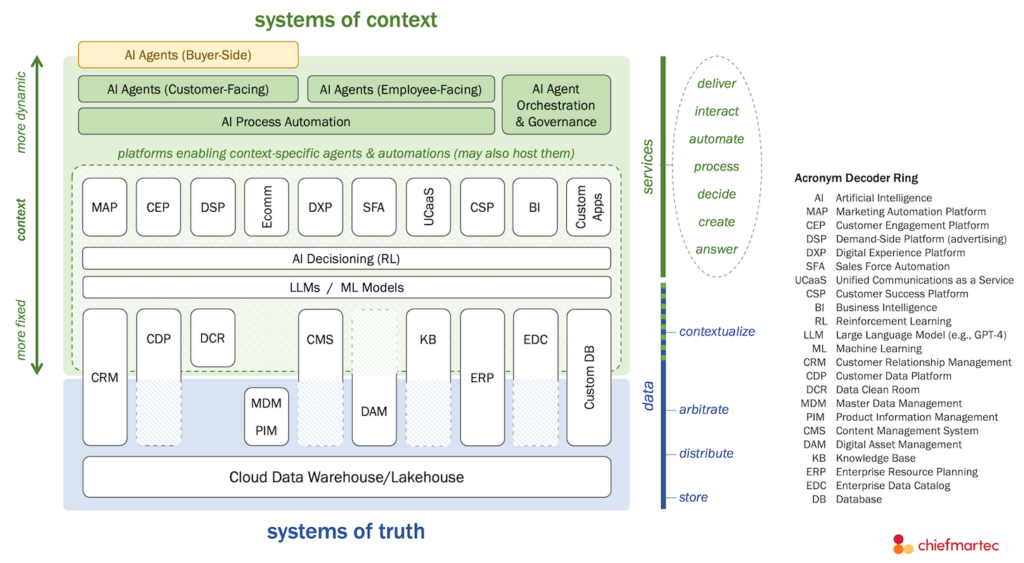This guest post is an excerpt from Digital & Marketing Asset Management: The Real Story of DAM Technology & Practice by Theresa Regli of Real Story Group. Theresa is a digital asset management expert, marketing technology analyst, and digital media strategist, and her clients include global brands such as Unilever, Nestlé, Net-a-Porter, IKEA, General Mills, and Coca-Cola.
A book about DAM would not be complete without putting DAM in the bigger picture, and by that I mean the bigger picture of Marketing Technology. A DAM by itself has limited usefulness: those assets have to be pushed out and used by different technologies in a wealth of ways for all this effort to benefit your organization.
Though DAM historically was implemented in a silo, used and maintained by only a few marketers or archivists, that’s changed. DAM is now fully embraced by the C-suite as a key enterprise application. Just as much effort is being put into DAM systems connecting to other systems as deploying simply the DAM, itself.
So how does DAM fit into the bigger picture of consumer-centric digital marketing? It’s not always obvious. Choosing the right tools for holistic and effective digital marketing is not unlike crafting a complex cocktail: you have to find the right mix of ingredients, and the right balance, that works for you.
What works for one organization might not work for yours, much like one person prefers a martini and someone else will prefer a negroni. Both drinks contain vermouth, just like two organizations might both have DAMs, but it’s the mixing with the other ingredients that make the results quite different, and the right mix for you.
As a digital marketer, you need to think of yourself as the enterprise technology mixologist, and work with your colleagues to come up with the right mix. So while DAM is obviously on your ingredient list, it’s equally important to plan for the others, and to understand the role that each technology plays. Otherwise, your cocktail will be crap, and no one will come back to your bar.
Here’s a few things for you to consider as you work with your colleagues to weave DAM into the enterprise digital marketing cocktail:
- I provide two digital marketing frameworks that complement each other to help you chart the course for digital marketing effectiveness
- A reference architecture built on foundations of customer- and product-centric data models can surface key gaps in systems and standards, and distinguish business services from business platforms
- A consumer-centric reference model aligns enterprise marketing investments with actual marketer and consumer needs
Content marketing isn’t just about creating the right content: the right digital marketing technology is needed for a content marketing strategy to be effective. You can’t attract, acquire, and engage an audience without a proper collection of systems to manage customer data, compelling content, and product information.
People often disagree on exactly what the term “MarTech” means. Construed very broadly, digital marketing technology is the collection/cocktail of digital systems that marketers use to gather, cultivate, and nurture leads and customers. Traditionally, these systems reflected how a marketer wanted to represent a brand or product line.
However, as marketing becomes (or aspires to become) more customer-centric, marketers increasingly sense that new approaches must focus much more intensely on customer preferences — including their browsing and buying history — and meet them in the channel of their choosing (mobile, in-store, catalog, or otherwise). Digital assets are instrumental to realizing this plan.
Top-performing brands already recognize that a superior customer experience is intrinsically tied to the quality of their digital channels, and companies that sell tangible products effectively tie together in-store and digital shopping experiences. However, the quest for effectiveness in omni-channel marketing is hampered by a lack of practical frameworks to assess current states, conduct multi-stakeholder analysis, and help charter custom roadmaps for enterprise contexts.
In this regard, traditional IT-oriented architectural reference models can provide a layered inventory of digital marketing systems and provide a baseline for further analysis of functional (i.e., business), integration, and security/privacy needs.
However, a complementary approach to digital marketing as a strategy, practice, and technology examines the efficacy and usability of marketing systems from the perspective of the customer. A customer-centric reference model can more closely tie systems analysis to business value via the pursuit of brand awareness, customer engagement, and increased sales.
Reference Enterprise Architecture
Figure 1: A traditional omni-channel marketing architecture reference model looks at systems in terms of layers — from the enterprise back-end, forward to the frontline screen. Image copyright Real Story Group, used with permission. Click for a larger image.
The optimal enterprise digital marketing architecture can be usefully represented as a series of technology layers, from bottom to top:
- Enterprise Data Foundation – Master product & customer data, analytics, and business intelligence.
- Major Marketing Technology Platforms – Marketing automation, digital asset management, web content management, and social media engagement to manage content and engagement.
- Prototypical Marketing & Sales Services – e-commerce, self-service applications, online video platforms, and content delivery networks, which are often all using digital assets in some form.
- Major Channels – Channels such as mobile devices, websites, and kiosks — these are the “presentation layers,” or “touch points” through which consumers access marketing & sales services.
Key Benefits
This approach represents an enterprise-centric view of digital marketing. Crucially, it takes a data-centric approach. Employ this type of reference model when:
- Holding discussions among disparate stakeholders, and you need to refer to a common set of terms and relationships
- Performing a rapid inventory of your key systems and frameworks; for example, you may be missing a consumer analytics tool or a product information management system – this will also influence your ability to measure the effectiveness of your assets
- Performing a “stoplight” analysis of where the enterprise is doing well or poorly; for example, you may be “green” in web content management, but only “red” in marketing automation and “yellow” in social engagement
- Distinguishing back-end data and content from the front-end user experience, and distinguishing marketing & sales services from underlying platforms
Figure 2: A customer-centered model puts consumer/customer experience at the center, and outlines layers of capabilities required to engage prospects and customers, creating more value both for them and your company. Image copyright Real Story Group, used with permission. Click for a larger image.
A customer-centric model puts the customer at the center of the marketing technology strategy. A key assumption here is that marketers’ efforts to better engage consumers or increase consumer loyalty are a win-win for both parties.
Consumers want to engage with brands, products, and services that are relevant to them; however, too often they struggle with digital experiences that frustrate this goal. Increased engagement results from explicitly shaping systems to address consumer needs and user experience — not just enterprise requirements. At the same time, consumer engagement must balance enterprise capabilities and concerns with consumer needs.
Key Benefits
A consumer-centered approach offers several benefits:
- It focuses your team. By making the consumer the subject of the equation, it supports better alignment of enterprise investments with actual consumer needs and desires.
- It clarifies the distinction between platforms (gray) and applications (purple). This distinction enables the enterprise to clearly separate roles and responsibilities, such that IT can own platforms, while business stakeholders can own specific applications.
- It lends itself to “RACI” models where you can assign Responsible/Accountable/Consulted/Informed participation within a responsibilities matrix. You can align your enterprise to be more agile and responsive to consumer needs.
- It germinates discussion of personas and tasks. These are the two essential building blocks for effective digital experiences.
Why these models are important
Marketing teams should work to expand their remit beyond just content marketing, website management or email automation toward a more integrated digital marketing experience writ large.
Like all reference models, use these as a common frame for internal communications and alignment. At a minimum, employ these models to inventory your current environment and self-assess the effectiveness of it. Marketing leaders can use these models in several ways to simply drive stakes into the ground, take stock, or set signposts for strategy.
Finally, note that these models are deliberately succinct, and you may need to revise them for your own context. Please feel free to contact me if you need help.
Thank you, Theresa!






Reading about reference enterprise architecture and the key benefits is quite fascinating. Thanks for sharing.